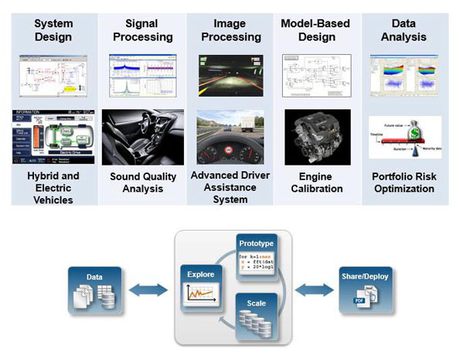Big data analytics
By Paul Pilotte, Technical Marketing Manager, MathWorks
Tuesday, 01 September, 2015

Up until recently, only data scientists were able to make sense of big data. Today, rather than hiring these specialists, companies expect their existing domain experts to be able to do the same work. Thankfully, analytics tools have evolved to address the challenges associated with big data, and you don’t have to be an expert at Java programming to use them.
In the field of engineering in particular, the accessibility of such tools is significant. No longer limited by the storage capacity of their workstations, engineers are now able to process large data sets from diverse and disparate sources to inform better decision making. From medical devices to oil and gas, automobiles and aviation, we’re seeing several industries take the next steps to accessing more of their data and building more sophisticated analytics.
Automotive companies are seeing their data analytics needs move beyond their design engineering departments to applications where they are integrating data analytics models into new systems and services. Some are taking fleet data from passenger and off-highway vehicles. They’re also capturing field data from hybrid electric vehicles so that their engineers can build models to optimise fuel efficiency. For large off-highway vehicles (think loaders, trucks and dozers used in mining operations), they’re capturing field data to ensure that they can meet service-level agreements and improve design reliability to maximise uptime.
Similarly, a medical device company wanted to bring in data from a vast pool of medical instruments and use these datasets to build neuroscience models. Once upon a time, these researchers would have had to be very familiar with Hadoop in order to achieve their goals; however, using big data tools from MathWorks, the company has been able to ingest, pre-process and apply machine-learning techniques to data without relying on the skills of mathematicians.
These sorts of applications are indicative of a trend where companies are accessing data from different sources and building complex models to better understand and predict how a design works in the real world.
For engineers, many of whom are trained using MATLAB, the tools’ big data processing capacities means they don’t need to upskill too much to put them to use. Instead, via a familiar, intuitive and interactive user interface, they can plot data and visualise that data in either two or three dimensions — particularly important in the exploration and modelling stages. With this processing power at their fingertips, engineers are able to improve designs and optimise operational performance that directly impacts their organisation’s bottom line.
When it comes to predicting which companies will benefit from data analytics moving forward, the financial services industry stands out. Organisations in this sector have long been employing tools for credit modelling, risk modelling and algorithmic trading, so the possibilities there will only continue to grow.
We’re also seeing some exciting activity around the industrial internet or Industrial Internet of Things (IIoT). Unlike the consumer Internet of Things, IIoT includes devices designed for harsh environments which are built to last for decades. The IIoT is set to really benefit from data analytics, and this includes many design engineering fields such as automotive, aerospace, industrial automation and process control.
Data analytics opens up a whole new universe for users in this area. Within the software and internet industries, we will see a lot of other manufacturing and machine-based companies benefit from the ability to bring data in, explore it, build models and integrate those models using a common modelling workflow. Engineering companies are finding that if they can access data from lots of different sources while using more sophisticated predictive analytics tools, like machine learning, they can make more informed and accurate decisions and become big data experts in their own right.
Memristor-based hardware to advance AI
A researcher from UMass Amherst is developing memristor-based hardware technology with the...
5G satellite tech advances global mobile connectivity
A global team has showcased new 5G satellite technology linking Singapore and Japan, enabling...
Can AI speed up critical communications chip design?
A team led by researchers from the University of Texas at Austin plans to add AI into the design...






